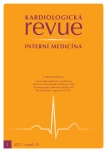Edoxaban – pharmacological profile
Authors:
R. Lábrová 1; K. Lábr 2
Authors‘ workplace:
Interní kardiologická klinika LF MU a FN Brno
1; I. interní kardioangiologická klinika LF MU a FN u sv. Anny v Brně
2
Published in:
Kardiol Rev Int Med 2017, 19(1): 45-50
Overview
Edoxaban is a direct inhibitor of factor Xa in the coagulation cascade. It reduces the formation of thrombin, prolongs clotting time and reduces the risk of development of blood clots. Its main therapeutic indication is the prevention of stroke and systemic embolism in adult patients with nonvalvular atrial fibrillation and the presence of one or more risk factors such as congestive heart failure, hypertension, age ≥ 75 years, diabetes mellitus, prior stroke or transient ischaemic attack. The efficacy and safety of edoxaban compared to warfarin was presented in the large clinical trial ENGAGE AF-TIMI 48, and in the ENSURE-AF study involving patients with atrial fibrillation undergoing synchronised electrical cardioversion. Another indication for edoxaban is the treatment of deep vein thrombosis, pulmonary embolism and prevention of recurrent vein thrombosis and pulmonary embolism. The study Hokusai-VTE showed that edoxaban is non-inferior to warfarin in the primary efficacy parameter. Regarding safety, there was a significant reduction of clinically relevant bleeding with edoxaban as compared to warfarin.
Keywords:
edoxaban – direct inhibitor of factor Xa – atrial fibrillation – thromboembolic disease – deep vein thrombosis – pulmonary embolism
Sources
1. Goldhaber SZ, Bounameaux H. Pulmonary embolism and deep vein thrombosis. Lancet 2012; 379(9828): 1835– 1846. doi: 10.1016/ S0140-6736 (11)61904-1.
2. Lábrová R, Špinar J. Antikoagulace, antiagregace nebo obojí u pacientů s ischemickou chorobou srdeční a fibrilací síní. Kardiol Rev Int Med 2016; 18(1): 47– 51.
3. Špinar J, Lábrová R. Antikoagulační terapie u fibrilace síní. Remedia 2011; 21(2): 168– 170.
4. Špinar J, Vítovec J. Edoxaban v klinických studiích a klinické praxi. Remedia 2016; 26(4):345– 348.
5. Čihák R, Haman L, Táborský M. Updated European Heart Rhythm Association Practical Guide on the use of non-vitamin K antagonist anticoagulants in patients with non-valvular atrial fibrillation: Summary of the document prepared by the Czech Society of Cardiology. Cor Vasa 2016; 58(1): e153– e174. doi: 10.1016/ j.crvasa.2016.01.006.
6. Heidbuchel H, Verhamme P, Alings P et al. Updated European Heart Rhythm Association Practical Guide on the use of non-vitamin K antagonist anticoagulants in patients with non-valvular atrial fibrillation. Europace 2015; 17(10): 1467– 1507. doi: 10.1093/ europace/ euv309.
7. SPC přípravku Lixiana. 2016. Dostupné z: http:/ / www.sukl.cz/ modules/ medication/ detail.php?kod=0210631.
8. Gugliano RP, Ruff CT, Braunwald E et al. The ENGAGE TIMI 48 Investigators. Edoxaban versus warfarin in patients with atrial fibrillation. N Engl J Med 2013; 369(22): 2093– 2104. doi: 10.1056/ NEJMoa1310907.
9. Goette A, Merino JL, Ezekowitz MD et al. Edoxaban versus enoxaparin– warfarin in patients undergoing cardioversion of atrial fi brillation (ENSURE-AF): a randomised, open-label, phase 3b trial. Lancet 2016; 388(10055): 1995– 2003. doi: 10.1016/ S0140-6736(16)31474-X.
10. Büller HR, Décousus H, Grosso MA et al. The Hokusai-VTE investigators. Edoxaban versus warfarin for the treatment of symptomatic venous tromboembolism. N Engl J Med 2013; 369(15): 1406– 1415. doi: 10.1056/ NEJMoa1306638.
Labels
Paediatric cardiology Internal medicine Cardiac surgery CardiologyArticle was published in
Cardiology Review

2017 Issue 1
Most read in this issue
- Diuretics and mineralocorticoid receptor antagonists in the therapy of chronic heart failure with reduced left ventricular ejection fraction
- COSYREL – a drug for patients with coronary artery disease and heart failure
- Rivaroxaban – pharmacological profile
- Late consequences of cardiotoxicity
